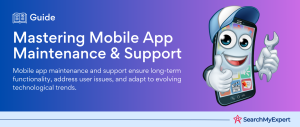Embarking on the journey of geolocation app development unveils a vast realm of opportunities. In the modern era, these apps have cemented their importance in enhancing user experiences and facilitating business growth. The increasing dependency on location-based services, especially during the times of global challenges, has underscored their value. As we progress, we will illuminate the path to developing a successful geolocation app.
Want to make a geolocation app? You’re in the right place! Here’s a simple guide on how these apps work, why they’re popular, and the industries using them.
What are Geolocation Apps?
These apps show where someone is on a map. They use the internet and a device’s GPS to work. Here’s what they can do:
- Share Location: Users can tell others where they are. For example, in chat apps like WhatsApp.
- Find Places: Apps like Airbnb suggest nearby places to stay. OpenTable helps find and book tables at close-by restaurants.
- Plan Routes: Apps like Google Maps suggest the best routes to take.
Why are Location
Apps Popular?
More people are using location apps for different reasons:
- Food Delivery: More people are ordering food online, so apps like UberEats are booming.
- Staying Fit: Fitness apps are getting popular, especially during lockdowns.
- Online Dating: Apps like Tinder have more users as meeting in person became limited.
- Business Use: Companies use these apps to track deliveries or show ads to people nearby.
Industries Using Geolocation
Many industries are finding creative ways to use geolocation:
- Shops: They send ads or offers to people close to their stores.
- Taxi Services: Apps like Uber make booking rides easy.
- Car Companies: They use GPS for things like tracking and route planning.
- Delivery Services: These track and update deliveries in real-time.
- Hotels and Eateries: They show nearby options and help in bookings.
- Health and Fitness: Apps track running routes or connect people to doctors online.
- Social Media: Apps like Instagram let users tag their location on posts.
- Games: Games like Pokemon GO use real-world locations for gameplay.
- Smart Devices: Home devices can change settings based on where users are.
Making a Geolocation App
When making an app, it’s important to decide how it will find locations:
1. Outdoor Tracking: This uses GPS or mobile towers.
- GPS: Very accurate but uses more battery.
- Cell ID: Uses nearby mobile towers. Good for city areas.
2. Indoor Tracking: This uses small devices called beacons to guide users inside big places, like malls.
In short, to make a successful geolocation app, think about what problem it will solve. With the right idea, these apps can be very useful and popular!
Key Tips for a Successful Geolocation App
When you’re diving into the world of geolocation apps, there are some things to keep in mind to ensure your app stands out and serves its users well:
- User Privacy: Always prioritize user privacy. Ask for permission before accessing their location and let them know how you’ll use it.
- Battery Usage: Keep an eye on how much battery your app uses. If it drains too quickly, users might uninstall it.
- Accuracy: Ensure your app provides accurate location details. Small errors can cause big inconveniences.
- Easy-to-use Interface: Your app should be straightforward. Users should be able to find what they’re looking for easily.
- Adaptability: Make sure your app works well in various settings, whether urban or rural, and adjusts to weak or strong internet signals.
- Feedback Mechanism: Allow users to give feedback on any issues or improvements. Listening to your users can help enhance the app.
- Updates: Regularly update your app to fix any bugs and add new features based on user feedback and technological advancements.
- Safety: Especially if your app is meant for social connections or sharing live locations, ensure there are safety features in place.
- Integration: Consider integrating your app with other popular services. For example, a fitness app might benefit from linking to health platforms or wearable devices.
- Marketing: Even the best app won’t be successful if people don’t know about it. Have a strong marketing strategy to promote your app and attract users.
The Future of Geolocation Apps
As technology evolves, so does the potential of geolocation apps. Here’s a glimpse into what the future might hold:
- Augmented Reality Integration: Merging AR with geolocation can elevate user experiences. Imagine pointing your phone at a restaurant and instantly seeing its menu, reviews, and availability.
- Improved Indoor Navigation: As beacon technology advances, indoor navigation can be as detailed as outdoor. This will revolutionize experiences in places like shopping malls, airports, and large corporate offices.
- Automated Actions: With advanced geolocation features, apps could perform actions when you’re at a specific location. For instance, your smart home could start preparing for your arrival as you near home.
- Advanced Analytics: For businesses, geolocation can offer advanced analytical data. Retail stores could analyze foot traffic patterns to optimize store layouts.
- More Sustainable Options: For travel or transportation-based apps, geolocation could suggest the most eco-friendly routes or transportation methods.
- Hyper-personalized Content: Based on location data, apps could offer highly personalized content or promotions. Imagine walking near a coffee shop and getting an instant coupon for your favorite drink.
- Enhanced Social Interactions: Geolocation could lead to innovative social media features, like finding nearby friends or joining location-based virtual events.
- Safety and Emergency Features: In emergency situations, geolocation apps could play a vital role, such as guiding users away from danger zones or helping emergency services locate individuals more efficiently.
- Integration with Wearables: As wearable technology like smartwatches becomes more common, expect tighter integration with geolocation apps for more immediate, on-the-go information.
- More Ethical Data Handling: As users become more conscious of their data privacy, there will be a push towards more ethical, transparent methods of collecting and using geolocation data.
Challenges and Solutions in Geolocation App Development
Every innovation comes with its set of challenges, and geolocation apps are no exception. However, by understanding these challenges, developers can take proactive measures to address them.
1.Data Privacy Concerns:
- Challenge: With increasing scrutiny on how companies handle user data, concerns over privacy infringement are valid.
- Solution: Implement robust encryption techniques, provide clear data usage policies, and ensure that users have control over their data.
2.Accuracy in Diverse Environments:
- Challenge: In areas with tall buildings or limited satellite visibility, maintaining accuracy can be tough.
- Solution: Utilize a combination of technologies, like Cell ID alongside GPS, and constantly update maps and databases.
3.High Battery Consumption:
- Challenge: Constant location tracking can drain device batteries.
- Solution: Optimize app processes, give users the flexibility to adjust location update frequency, and utilize low-energy consumption technologies like beacons for indoor tracking.
4.Diverse Platform Compatibility:
- Challenge: Different devices and operating systems can interpret and execute geolocation functionalities differently.
- Solution: Ensure rigorous cross-platform testing and stay updated with the latest OS changes and updates.
5.Over-reliance on External Services:
- Challenge: Many apps rely heavily on third-party services for maps or location data.
- Solution: While integration is beneficial, have backup options or invest in creating proprietary databases or tools.
6.Handling Real-time Data:
- Challenge: Real-time data processing can be resource-intensive.
- Solution: Invest in efficient backend systems, utilize cloud-based solutions, and ensure the app is optimized for performance.
7.Global Localization:
- Challenge: Geolocation apps catering to a global audience might face localization challenges, such as displaying content in local languages or understanding local nuances.
- Solution: Implement multi-language support and collaborate with local experts to ensure accurate content representation.
8.Safety and Misinformation:
- Challenge: There are concerns about the misuse of location data, leading to safety issues or spreading misinformation.
- Solution: Implement strong verification systems, continuously monitor user-generated content, and provide users with safety features like emergency buttons or anonymity options.
The Importance of Continuous Learning
The world of geolocation is vast, dynamic, and ever-evolving. For developers and businesses, staying static isn’t an option. Continuous learning, attending tech conferences, engaging in communities, and regularly updating skills are essential.
It’s also beneficial to foster a culture of feedback within the user base. Their insights, combined with technological advancements, can guide the app’s evolution, ensuring it remains valuable and resonates with its audience.
Here Is The Flowchart Showing the Geolocation App Development

In Conclusion
Geolocation apps are undeniably reshaping the way we interact with the world around us. As the bridge between the digital and physical realms, they offer unparalleled convenience, insights, and opportunities. By addressing challenges head-on and staying committed to innovation, these apps hold the promise of an interconnected, informed, and enhanced future for all.
Make Waves in the app industry with these Mobile App Developers.
Further Reading
- AR VR App Development
- Integrating Payment Gateways In Mobile Apps
- Mastering Messaging App Development
- In-App Purchases
- Push Notifications
- User Authentication
- Social Media Integration App Development
- Multilingual Mobile App Creation
- Offline Mobile App Development
Table of Contents
Toggle






